Glossary of Shinto
This is a dynamic list and may never be able to satisfy particular standards for completeness. You can help by expanding it with reliably sourced entries.
This is the glossary of Shinto, including major terms the casual (or brand-new) reader might find useful in understanding articles on the subject. Words followed by an asterisk (*) are illustrated by an image in one of the photo galleries. Within definitions, words set in boldface are defined elsewhere in the glossary.
| Part of a series on |
| Shinto |
|---|
 |
| Practices and beliefs |
| Shinto shrines |
| Notable Kami |
| Important literature |
|
| See also |
|
|
A
- Aku (悪) - Evil. The term's meaning is however not limited to moral evil, and includes misfortune, inferiority, and unhappiness.[1]
- Amaterasu Ōmikami - The Sun Goddess, tutelary kami and ancestor of the Emperor, enshrined at Ise Shrine.[1]
- an* - a small table or platform used during Shinto ceremonies to bear offerings. It may have four, eight or sixteen legs.
- Anzen (安全) - Safety, particularly safety at work, frequently requested from a kami, and in fact corporations often have a tutelary shrine specifically to ensure their business prospers.[1]
- aramitama - The rough and violent side of a spirit (mitama).[2]
B
- bekkū or betsugū (別宮) - Subsidiary shrine next to the honden, which may however enshrine an equally important kami.[1]
- Benzaiten - Originally Buddhist goddess Sarasvati, now a syncretic goddess member of the seven lucky gods. Her Shinto name is Ichikishima-hime-no-mikoto (市杵島姫命).[1]
- bettō - before the shinbutsu bunri, when the Meiji period law forbade the mixing of Shinto and Buddhism, a bettō was a monk who performed Buddhist rites at a Shinto shrine.
- Bishamonten - Syncretic deity of Buddhist origin part of the Seven Lucky Gods.[1] A symbol of authority, he protects warriors.
- Bon Matsuri - a festival celebrated around July 15 in order to console the spirits of the dead. In theory a Buddhist festival, but in practice an ancestor and family festival part of Shinto.[1]
- Bosatsu (菩薩) - Bodhisattva. Term of Buddhist origin which however was and is often used for deities of mixed Buddhist/Shinto ancestry like Benzaiten and Jizō, kami like Hachiman and even deified human beings like Tokugawa Ieyasu.[1]
- buden (舞殿) - see kaguraden.
- bunrei (分霊) - process of division of a kami producing two complete copies of the original, one of which is then transferred to a new shrine through a process called kanjō.
- bunsha (分社) - Shrine part of a network headed by a famous shrine, from whence its kami was transferred through an operation called kanjō.[1]
- butsudan - Buddhist altar found in Japanese homes enshrining a family's ancestors.[1]
C
- chigi* (千木) - Forked decorations common at the ends of the roof of shrines.
- chinju - the tutelary kami or tutelary shrine of a certain area or Buddhist temple.
- chinjusha* - a small shrine dedicated to the tutelary kami of an area or building.[1]
- chōchin - paper lanterns always present at Shinto festivals (matsuri)
- chōzuya - see temizuya.
D
- Daijōsai (大嘗祭) - Ceremony marking the beginning of an Emperor's reign in which he offers first fruits to ancestors, including Amaterasu.[1] The Emperor then shares a meal with the goddess.
- Dai-gongen - see gongen.
- Daikokuten - syncretic god part of the seven lucky gods fusing Buddhist god Mahakala and kami Ōkuninushi.[1]
- Dōsojin - group of kami and Buddhist gods protectors of roads, borders and other places of transition.[1]
E
- Ebisu - god of prosperity found at both temples and shrines. One of the Seven Lucky Gods.
- ema* - small wooden plaques on which worshipers at shrines, as well as Buddhist temples, write their prayers or wishes.
F
- fox - See kitsune.
- Fuji (Mount) - The most famous among Japan's sacred mountains, it is inhabited by a kami called Konohanasakuya-hime.[1]
- Fukkō Shintō (復興神道) - name synonymous with kokugaku.
G
- go-hei* - also called onbe (御幣) or heisoku (幣束). A wooden wand decorated with two shide (zigzag paper streamers) and used in Shinto rituals as a yorishiro.
- gongen
- A Buddhist god that chooses to appear as a Japanese kami to take the Japanese to spiritual salvation.
- Name sometimes used for shrines (e.g. "Tokusō Gongen") before the shinbutsu bunri.
- gongen-zukuri - a shrine structure in which the haiden, the heiden and the honden are interconnected under the same roof in the shape of an H.*
- Goryō (御霊) - A soul, angry for having died violently or unhappy, which needs to be pacified through Buddhist rites or enshrinement, like Sugawara no Michizane.[1]
- goshintai - see shintai.
- Gozu-tennō (牛頭天王) - Buddhist name of kami Susanoo, considered an avatar of Yakushi Nyorai.[1]
- -gū (宮) - suffix of certain shrine names indicating it enshrines a member of the imperial family.[1] Hachiman-gū shrines for instance enshrine Emperor Ojin.
H
- Hachiman (Bosatsu) - Popular syncretic kami tutelary god of the warrior class. First enshrined at Usa Hachiman-gū, it consists of three separate figures, Emperor Ōjin, his mother and his wife Himegami.[1]
- Hachiman-zukuri - Shinto architectural style in which two parallel structures with gabled roofs are interconnected on the non-gabled side forming a single building which, when seen from the side, gives the impression of two.[3]
- haibutsu kishaku - Literally "Destroy Buddha, kill Shakyamuni", it was the slogan of a Meiji period anti-Buddhist movement responsible for the destruction of thousands of Buddhist temples.
- haiden* - literally "hall of prayer". A shrine building dedicated to prayer, and the only one of a shrine open to laity.
- Hakusan - collective name given to three mountains worshiped as kami and sacred to the Shugendō.[4] Hakusan shrines are common all over Japan.
- hamaya (破魔矢) - Literally "evil breaking arrow". Arrows bought for good luck at shrines at New Year's and kept at home all year.[1]
- han-honji suijaku - theory initiated by Yoshida Kanetomo which reversed the standard honji suijaku theory, asserting Buddhist gods were just avatars of Japanese kami.[1]
- haraegushi (祓串) - an ōnusa having an hexagonal or octagonal wand.
- harae (祓) - general term for rituals of purification in Shinto.[1]
- hassoku-an - See an.
- Hatsumōde - the first shrine visit of the New Year. Some shrines, for example Meiji Shrine in Harajuku, Tokyo, see millions of visitors in just a few days.
- heiden - a section of a shrine where offerings are presented to the gods.
- heihaku (幣帛) - see go-hei.
- himorogi - temporary sacred spaces or altars used to worship. Usually, himorogi are simply areas demarcated with green bamboo or sakaki at the four corners supporting sacred border ropes called shimenawa.
- hiōgi (檜扇) - a fan used originally by Heian aristocrats and now by Shinto priests.[1]
- hirairi or hirairi-zukuri - a style of construction in which the building has its main entrance on the side which runs parallel to the roof's ridge (non gabled-side). The shinmei-zukuri, nagare-zukuri, hachiman-zukuri, and hie-zukuri styles belong to this type.
- Hōhei/hōbei (奉幣) - offerings made to a kami, usually consisting in heihaku, but sometimes of jewels, money, weapons or other objects.[1]
- hokora/hokura (祠, 神庫)
- an extremely small shrine
- One of the earliest words for shrine
- honden - literally "main hall". Also called shinden (神殿) ("divine hall"), the honden is the most sacred building of a shrine, intended for the exclusive use of the enshrined kami.
- honji suijaku - theory dominant for centuries in Japan according to which Japanese kami are simply local manifestations of Indian gods.
- hongū (本宮) - only in a jingū, the main shrine enshrining the principal kami, as opposed to betsugū, sessha or massha. The term includes haiden, heiden and honden.[1] See also honsha.
- honsha (本社) - main shrine of a shrine complex. It is followed hierarchically by sessha and massha.
- hotoke - Term meaning either Buddha or "dead soul". While Buddhist in origin, the term is used in the second sense by all Japanese religions.[1]
- hyakudoishi (百度石) - literally "hundred times stone". Sometimes present as a point of reference for the hyakudomairi near the entrance of a shrine or Buddhist temple.
- hyakudomairi (百度参り) - literally "a hundred visits". A worshiper with a special prayer will visit the shrine a hundred times. After praying, he or she must go at least back to the entrance or around a hyakudo-ishi for the next visit to count as a separate visit.
Gallery: A to H
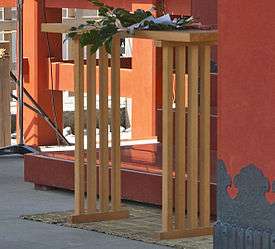 A hassoku-an
A hassoku-an Chigi (forked decorations)
Chigi (forked decorations) An ema
An ema A hokora
A hokora A hyakudoishi
A hyakudoishi A gohei
A gohei A haiden
A haiden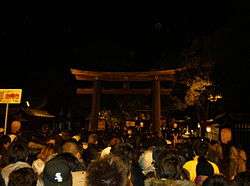 Hatsumōde at Meiji Shrine, Shibuya, Tokyo
Hatsumōde at Meiji Shrine, Shibuya, Tokyo
I
- Ichikishima-hime-no-mikoto - See Benzaiten.
- imi (忌み) - Something to be avoided or polluting, particularly to a ceremony.[1]
- Inari Ōkami* (稲荷大神) - the kami of fertility, rice, agriculture, foxes, industry, and worldly success. Inari shrines can be easily identified by the stone foxes which protect it.
- imikotoba (忌み言葉) - words to be avoided in certain occasions. For example, one should not use words as "cut", "end" and the like at weddings because of bad omen or Buddhist terms at certain Shinto shrines or rites.[1]
- ireisai (慰霊祭) - festival to remember and pacify the spirits of war dead which take place at Yasukuni Jinja and other shrines built to the purpose.[1]
- Ise Shrine - shrine in Mie prefecture considered one of the holiest Shinto sites.
- Ise Shinto - See Watarai Shinto.
- itako/ichiko (神巫・巫子・市子) - blind female shamans from North-West Honshu which act as a link between human beings and kami, echoing what was probably the former role of miko in Shinto.[1]
- iwakura (磐座)* - a rock where a kami has been invited to descend for worship, and which is therefore sacred. See the article yorishiro.
- iwasaka (岩境) - a stone altar or mound erected in the distant past to call a kami for worship. See the article yorishiro.
- Izanagi and Izanami - Brother-and-sister couple which, according to the Nihongi and Kojiki, gave birth to Japan.[1]
J
- jichinsai (地鎮祭) - lit. "ground pacify ceremony", ceremony held by a Shinto priest on a site before the start of construction on behalf of owners and workers to pacify and propitiate local spirits.[1]
- jingi (神祇) - kami
- Jingikan - In the ritsuryō system, the part of government responsible for matsuri.[1]
- jingū (神宮) - a shrine enshrining a member of the Imperial family, as for example Meiji Jingū which enshrines the deified spirits of Emperor Meiji and his wife, Empress Shōken.
- Jingū-ji - lit. "shrine temple". A temple whose existence is supposed to help the soul of the kami the shrine next to it enshrines. This kind of association was common until the Meiji period.[1]
- jinja* (神社) - the most general name for a shrine, as in Yasukuni Jinja.
- Jinja Fukkyū (神社復旧) - lit- "jinja restoration", a reversal of the Meiji period's Jinja Gappei (lit. "jinja merger". Not to be confused with jinja fukushi.[1]
- Jinja Fukushi (神社福祉) - lit. "jinja welfare", a form of unofficial, and therefore illegal, restoration of a merged shrine. See Jinja Gappei.[1]
- Jinja Gappei (神社合併) - lit. "jinja merger" - Policy begun in the early '900, when as many as 83 000 shrines (half the total) were merged with the remainder and disappeared.[1]
- Jinja Honchō - In English "Association of Shinto Shrines", an association that includes most (but not all) of the Shinto shrines in Japan.[1]
- Jinja kaikan (神社会館) - a hotel-like building within large shrines used for weddings.
- Jinja Shintō (神社神道) - originally a synonym of State Shinto (Kokka Shinto), it is now a term criticized by specialists as problematic.[1] When applied to post-war Shinto, it means the beliefs and practices associated to shrines, particularly those associated with the Jinja Honchō.[1]
- Jisha - Lit. "temple-shrine". A temple's tutelary shrine. See chinjusha.
- jōe (浄衣) - garment worn by kannushi during religious ceremonies. A silk kariginu.
- Junpai (巡拝) - The custom of visiting a fixed series of 33 or 88 shrines, temples or shrines and temples.[1] Famous the 88 temple "Shikoku Pilgrimage" circuit.
K
- kadomatsu (門松) New Year decorations placed in pairs in front of homes to welcome the kami of harvest.
- kaguraden* (神楽殿) - a pavilion or stage dedicated to the performing of the kagura (sacred dance). Also called maidono or buden (舞殿).
- kaeru (かえる) - lit. "frog". Because the word kaeru means both "frog" and "return home", many shrines sell small frog figurines as lucky charms.[1]
- kagura (神楽) - literally "sacred dance".
- A type of Shinto dance with deep ties to the Emperor and his family, accompanied by instruments. Also called mikagura (御神楽).
- A type of Shinto dance performed at shrines during religious rites, with many local variants. Also called satokagura (里神楽).
- kakuriyo (隠り世) - lit. "hidden world", meaning either the world of kami and spirits, or the world of the dead (Yomi) [1]
- kamadogami (竃神) - a kami which lives in people's ovens.
- kami (神) - term broadly meaning "spirit" or else "deity", but having with several separate meanings.
- deities mentioned in Japanese mythologies and local deities protecting areas, villages and families.[5]
- unnamed and non-anthropomorphic spirits found in natural phenomena.[5]
- a general sense of sacred power.[5]
- According to a famous definition by Motoori Norinaga, a kami is "any thing or phenomenon that produces the emotions of fear and awe, with no distinction between good and evil".
- Kamiarizuki (神有月) - lit. "month with gods"; lunar calendar month corresponding roughly to October. Because it is believed that in that month all kami go to Izumo Taisha, it is called "month with gods" at Izumo, Kannazuki ("month without gods" (神無月)) elsewhere.[1]
- kamidana* (神棚) - literally "kami shelf". A miniature shrine placed or hung high on a wall in some Japanese homes.
- kamimukae (神迎え) - lit. "summoning the kami", the first part of a typical festival (matsuri).[1] The spirit is usually invited to a himorogi (altar).
- kanjō - a process through which a kami (usually obtained dividing in two another kami through a process called bunrei) is transferred to a new shrine.
- Kannagara no Michi (惟神の道) - Another name for Shinto in use before World War II.[1]
- Kannazuki - See Kamiarizuki.
- kannushi* (神主) - a Shinto priest.
- kasoegi (斗木) - see katsuogi.
- Kasuga (春日) - the tutelary kami (ujigami) first just of the Fujiwara clan, then of the entire Yamato province.[1]
- Kasuga-zukuri (春日造) - The architectural style of Kasuga taisha.
- katsuogi* (鰹木, 勝男木, 葛緒木) - short decorative poles on a shrine's roof set at a right angle to the roof's ridgepole.
- kegare (穢れ) - defilement due to natural phenomena, for example the contact with dead bodies.
- kibitsu-zukuri (吉備津造) - the architectural style of Kibitsu Jinja in Okayama prefecture, characterized by a huge honden divided in three parts with an interior painted in vermilion, black and gold.[1]
- kitsune* (狐) - statue or image of a fox, animal believed to have magical powers and to be a messenger to kami Inari. Inari shrines are always protected by statues of foxes, sometimes wearing red votive bibs.
- kō (講) - a lay worship group focusing on a particular kami or sacred location which may perform pilgrimages and other rites.
- kōdō (皇道) - lit. the Imperial Way, or Shinto as defined by post-Meiji nationalist.[1]
- Kōgakkan University (皇学館大学) - University located near Ise Shrine, together with Tokyo's Kokugakuin University the only one authorized to train Shinto priests.
- Kokka Shinto (国家神道) - Japanese translation of the English term State Shinto created in 1945 by the US occupation forces to define the post-Meiji religious system in Japan.
- Kokugakuin University - Tokyo university which is, together with Ise's Kōgakkan University, the only one authorized to train Shinto priests.
- komainu* (狛犬) - stone warden dogs usually present at the entrance of a shrine.
- kotodama or kototama (言霊) - supernatural power possessed by words capable of influencing matter.
- Kunitokotachi-no-mikoto - kami considered to be the most important by Yoshida Kanetomo and considered important also by Watarai Shinto.[1]
- Kyōha Shinto (教派神道) - lit. Sect Shinto, a label applied to certain sects by the Meiji government to give them an official status.[1]
Gallery: I to K
 A man confronted with an apparition of Inari, appearing in this case as a woman
A man confronted with an apparition of Inari, appearing in this case as a woman An iwakura (the Meoto Iwa) girdled by a shimenawa
An iwakura (the Meoto Iwa) girdled by a shimenawa A jinja (shrine), characterized by the presence of a torii
A jinja (shrine), characterized by the presence of a torii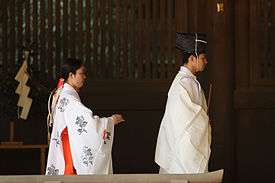 A kannushi (right) wearing a jōe
A kannushi (right) wearing a jōe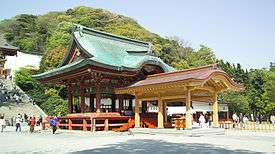 A kaguraden
A kaguraden A kamidana
A kamidana A kannushi during a wedding
A kannushi during a wedding- Katsuogi (poles perpendicular to the roof ridge) at Ise Shrine

 A komainu
A komainu
M
- magatama* (勾玉 or 曲玉) - a comma shaped jewel often used as a yorishiro.
- maidono (舞殿) - see kaguraden.
- massha* (末社) - a synonym of sessha.
- miko* (巫女, 神子, 巫)
- A woman who helps kannushi in their work.
- A woman possessing magic powers and capable of giving oracles (shamanness).
- mikoshi* (神輿) - a divine palanquin (often improperly translated as portable Shinto shrine).
- misogi* (禊) - an ascetic practice of ritual purification.
- mitama - The spirit of a kami or the soul of a dead person.[6]
- miya (宮) - often defines a shrine enshrining a special kami or a member of the Imperial household, for example an Empress, but can also simply mean shrine.
- miyamairi (宮参り) - is a traditional rite of passage for newborns held at a shrine.
- mori (杜 or 森) - a wood, a forest, a grove. Here: a shrine grove or forest. It reflects close relationship between trees and shrines. Tree worship is common in Shinto.
N
- nusa (幣)- See ōnusa.
O
- Ōkuninushi - see Daikokuten
- omamori (お守り) - amulets on sale at shrines and temples for particular purposes, for example health or success in business.
- omikuji* (御御籤 or 御神籤) - oracles written on strips of paper often found at shrines wrapped around tree branches.
- Ōnusa (大幣) or haraegushi (祓串) - wooden wands used in rituals. Decorated with many shide, they are waved left and right during ceremonies.
- Ōyashiro (大社) - see Taisha.
Gallery: L to O
 Jōmon period magatama
Jōmon period magatama_massha.jpg) Massha at Katsuragi Shrine in Gose, Nara
Massha at Katsuragi Shrine in Gose, Nara A miko at Kasuga Shrine
A miko at Kasuga Shrine- A mikoshi
 Omamori on sale
Omamori on sale An ōnusa
An ōnusa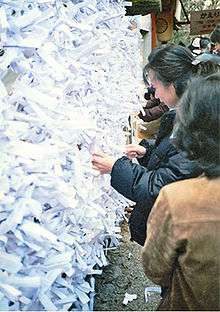 Tying omikuji at Kasuga Shrine in Nara
Tying omikuji at Kasuga Shrine in Nara
S
- saikigū (祭器具) - utensils used in religious ceremonies, including the following: sanbō, oshiki, hassoku-an, takatsuki.
- sanbō (三方) - a stand used to bear food offerings, usually made of unpainted hinoki (Japanese cypress).
- saisen (賽銭) - offerings from worshipers. The box collecting the offerings is called saisen-bako (賽銭箱) (lit. saisen box), usually situated near the entrance, or in front of the halls of a shrine, as well as of a Buddhist temple.
- sakaki (榊) - a flowering evergreen tree native to Japan often used in rituals, for example to make tamagushi.
- sandō* (参道) - the approach leading from a torii to a shrine. The term is also used sometimes at Buddhist temples too.
- sanpai sahō (参拝作法) − the way in which the Japanese worship at shrines, bowing twice, clapping twice, then bowing one last time.
- seisatsu* (制札) - a signboard containing announcements and rules for worshipers.
- sessha* (摂社) - smaller shrine housing a kami having a strong relationship with that of the honsha. A synonym of massha.
- shaku (笏)- a flat baton often seen in portraits of noblemen and samurai, but also used by kannushi. Has a purely decorative function.
- shamusho (社務所) - a shrine's administrative office. It often sells omamori and other goods.
- shide* (垂, 紙垂, 四手) - a zigzag-shaped paper streamer, often attached to a shimenawa or tamagushi and used in rituals.
- shimboku* (神木) - a tree considered divine, usually surrounded by a shimenawa.
- shimenawa* (標縄・注連縄・七五三縄) - lit. "enclosing rope". A length of braided rice straw rope used for ritual purification.
- shinbutsu bunri (神仏分離) - the forbidding by law of the syncretism of Shinto and Buddhism, and the effort to create a clear division between Shinto and Buddhism on one side, and Buddhist temples and Shinto shrines on the other.
- shintai (神体) - lit. "divine body". A sacred object, usually a mirror, a jewel, or a sword, which represents the kami for worship.
- shrine - English word which translates several more specialized Japanese words (see article Shinto shrine). Any structure housing ("enshrining") a kami. See also hokora (extremely small shrine), jinja, jingū, massha (subordinate shrine, a synonym of sessha), miya, mori (shrine grove), taisha, yashiro.
- shinbutsu kakuri (神仏隔離) − the tendency in medieval and early modern Japan to keep particular kami separate from any form or manifestation of Buddhism.
- shinbutsu shūgō (神仏習合) - syncretism of Buddhism and local religious beliefs, the normal state of things before the shinbutsu bunri.
- Shūha Shintō (宗派神道) - see Kyōha Shintō.
- State Shinto (国家神道 Kokka Shintō) - term first used after World War II to broadly classify Shinto ideals, rituals and institutions created by the pre-War government to promote the divinity of the emperor and the uniqueness of Japan (kokutai).
Gallery: P to S
 A saisen-bako, or offertory box
A saisen-bako, or offertory box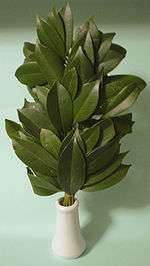 Sakaki branches
Sakaki branches A sandō (a shrine's approach)
A sandō (a shrine's approach) A seisatsu
A seisatsu- Sessha (Tsukkomi no Miya) at Ise Grand Shrine
 Two kannushi holding a shaku
Two kannushi holding a shaku Two shide decorating a small shrine
Two shide decorating a small shrine- A shimenawa
 A shimboku girdled by a shimenawa
A shimboku girdled by a shimenawa
T
- Taisha (大社) - literally "great shrine", this term is usually part of the official name of a shrine, as for example in Izumo Taisha.
- taisha-zukuri (大社造) - the oldest style of shrine architecture used for example at Izumo Taisha and thought to resemble that of ancient habitations.
- tamagaki (玉垣) - The fence delimiting the sacred soil of a shrine.
- tamagushi* (玉串) - literally "jewel skewer". A form of offering made from a sakaki-tree branch and strips of paper, silk, or cotton.
- temizuya* (手水舎) - a fountain near the entrance of a shrine or at a Buddhist temple where worshipers can cleanse their hands and mouths before worship.
- torii* (鳥居)- the iconic Shinto gate at the entrance of a sacred area, usually a shrine.
- tōrō (灯籠) - a lantern at a shrine or Buddhist temple.
- tsumairi or tsumairi-zukuri(妻入・妻入造) - a style of construction in which the building has its main entrance on the side which runs perpendicular to the roof's ridge (gabled side). The taisha-zukuri, sumiyoshi-zukuri, ōtori-zukuri and kasuga-zukuri architectural styles belong to this type.
Y
- yashiro (社)- generic term for shrine, similar to jinja.
- yorishiro (依り代)- an object capable of attracting kami for a ceremony. Trees, rocks, magatama, gohei, even persons can be a yorishiro.
- yorimashi (憑坐) - a human yorishiro, in particular a child or woman, used by a faith healer for oracles.
Gallery: T to Z
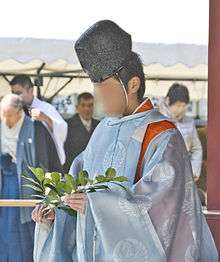 A kannushi holding a tamagushi
A kannushi holding a tamagushi A temizuya
A temizuya A torii
A torii A tōrō
A tōrō
Notes
- 1 2 3 4 5 6 7 8 9 10 11 12 13 14 15 16 17 18 19 20 21 22 23 24 25 26 27 28 29 30 31 32 33 34 35 36 37 38 39 40 41 42 43 44 45 46 47 48 49 50 51 Bocking, Brian (1997). A Popular Dictionary of Shinto. Routledge. ISBN 978-0-7007-1051-5.
- ↑ Yonei, Teruyoshi. "Aramitama". Encyclopedia of Shinto. Kokugakuin University. Retrieved 5 February 2011.
- ↑ JAANUS, Hachiman-zukuri accessed on December 1, 2009
- ↑ Nogami, Takahiro: "Hakusan Shinkō". Encyclopedia of Shinto, Kokugakuin University, retrieved on August 8, 2011
- 1 2 3 Smyers (1999:219)
- ↑ Iwanami Kōjien (広辞苑) Japanese dictionary, 6th Edition (2008), DVD version
References
- Basic Terms of Shinto, Kokugakuin University, Institute for Japanese Culture and Classics, Tokyo 1985
- Ono, Sokyo, Shinto: The Kami Way, Charles E. Tuttle Company, Tokyo 1992, ISBN 0-8048-0525-3
- Encyclopedia of Shinto, Kokugakuin University, accessed on April 2, 2009
- Iwanami Kōjien (広辞苑) Japanese dictionary, 6th Edition (2008), DVD version
- Japanese Art Net User System Dictionary of Japanese Architectural and Art Historical Terminology accessed on April 2, 2009
- Smyers, Karen Ann (1999). The Fox and the Jewel: Shared and Private Meanings in Contemporary Japanese Inari Worship. Honolulu: University of Hawaii Press. ISBN 0-8248-2102-5. OCLC 231775156.
This article is issued from Wikipedia - version of the 4/6/2016. The text is available under the Creative Commons Attribution/Share Alike but additional terms may apply for the media files.